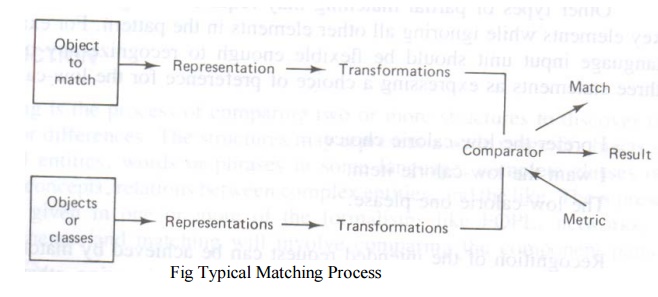Chapter: Artificial Intelligence
Matching techniques
Matching techniques:
Matching
is the process of comparing two or more structures to discover their likenesses
or differences. The structures may represent a wide range of objects including
physical entities, words or phrases in some language, complete classes of things,
general concepts, relations between complex entities, and the like. The
representations will be given in one or more of the formalisms like FOPL,
networks, or some other scheme, and matching will involve comparing the
component parts of such structures.
Matching
is used in a variety of programs for different reasons. It may serve to control
the sequence of operations, to identify or classify objects, to determine the
best of a number of different alternatives, or to retrieve items from a
database. It is an essential operation such diverse programs as speech
recognition, natural language understanding, vision, learning, automated
reasoning, planning, automatic programming, and expert systems, as well as many
others.
In its
simplest form, matching is just the process of comparing two structures or
patterns for equality. The match fails if the patterns differ in any aspect.
For example, a match between the two character strings acdebfba and acdebeba
fails on an exact match since the strings differ in the sixth character
positions.
In more
complex cases the matching process may permit transformations in the patterns
in order to achieve an equality match. The transformation may be a simple
change of some variables to constants, or ti may amount to ignoring some
components during the match operation. For example, a pattern matching variable
such as ?x may be used to permit successful matching between the two patterns
(a b (c d ) e) and (a b ?x e) by binding ?x to (c, d). Such matching are
usually restricted in some way, however, as is the case with the unification of
two classes where only consistent bindings are permitted. Thus, two patterns
such as
( a b (c
d) e f) and (a b ?x e ?x)
would not
match since ?x could not be bound to two different constants.
In some
extreme cases, a complete change of representational form may be required in
either one or both structures before a match can be attempted. This will be the
case, for example, when one visual object is represented as a vector of pixel
gray levels and objects to be matched are represented as descriptions in
predicate logic or some other high level statements. A direct comparison is
impossible unless one form has been transformed into the other.
In
subsequent chapters we will see examples of many problems where exact matches
are inappropriate, and some form of partial matching is more meaningful.
Typically in such cases, one is interested in finding a best match between
pairs of structures. This will be the case in object classification problems,
for example, when object descriptions are subject to corruption by noise or
distortion. In such cases, a measure of the degree of match may also be
required.
Other
types of partial matching may require finding a match between certain key
elements while ignoring all other elements in the pattern. For example, a human
language input unit should be flexible enough to recognize any of the following
three statements as expressing a choice of preference for the low-calorie food
item
I prefer
the low-calorie choice.
I want
the low-calorie item
The
low-calorie one please.
Recognition
of the intended request can be achieved by matching against key words in a
template containing “low-calorie” and ignoring other words except, perhaps,
negative modifiers.
Finally,
some problems may obviate the need for a form of fuzzy matching where an
entity’s degree of membership in one or more classes is appropriate. Some
classification problems will apply here if the boundaries between the classes
are not distinct, and an object may belong to more than one class.
Fig 8.1
illustrates the general match process where an input description is being
compared with other descriptions. As stressed earlier, their term object is
used here in a general sense. It does not necessarily imply physical objects.
All objects will be represented in some formalism such a s a vector of
attribute values, prepositional logic or FOPL statements, rules, frame-like
structures, or other scheme. Transformations, if required, may involve simple
instantiations or unifications among clauses or more complex operations such as
transforming a two-dimensional scene to a description in some formal language.
Once the descriptions have been transformed into the same schema, the matching
process is performed element-by-element using a relational or other test (like
equality or ranking). The test results may then be combined in some way to
provide an overall measure of similarity. The choice of measure will depend on
the match criteria and representation scheme employed.
The output
of the matcher is a description of the match. It may be a simple yes or no
response or a list of variable bindings, or as complicated as a detailed
annotation of the similarities and differences between the matched objects.
`To
summarize then, matching may be exact, used with or without pattern variables,
partial, or fuzzy, and any matching algorithm will be based on such factors as
Choice of
representation scheme for the objects being matched,
Criteria
for matching (exact, partial, fuzzy, and so on),
Choice of
measure required to perform the match in accordance with the
chosen
criteria, and
Type of
match description required for output.
In the
remainder of this chapter we examine various types of matching problems and
their related algorithms. We bin with a description of representation
structures and measures commonly found in matching problems. We next look at
various matching techniques based on exact, partial, and fuzzy approaches. We
conclude the chapter with an example of an efficient match algorithm used in
some rule-based expert systems.

Related Topics